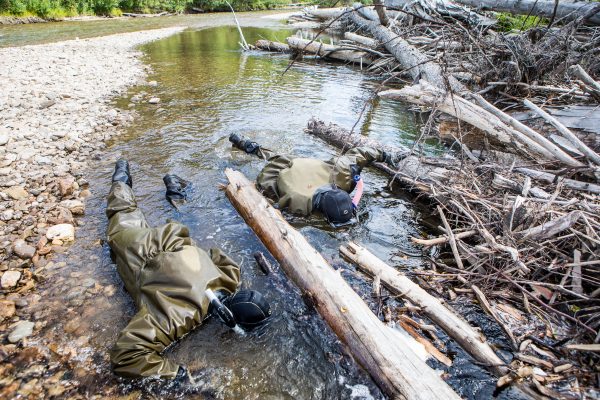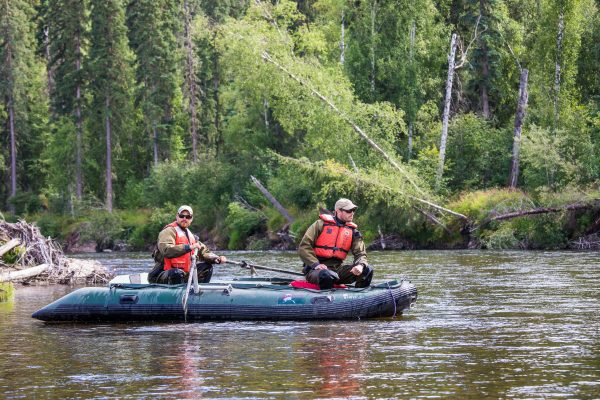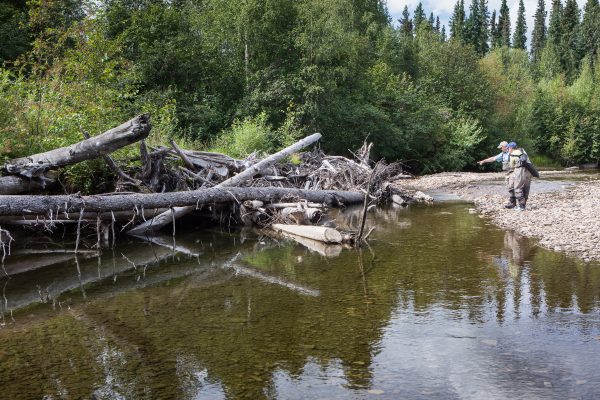Chena logjams could be key to salmon survival
October 10, 2017
Lauren Frisch
907-474-5350

Download text and photo captions here.
The plentiful logjams that line the Chena River can be annoying, scary or even dangerous for kayakers and canoers traveling downstream. But researchers believe they could be safe and supportive habitats allowing young salmon to survive the treacherous journey to adulthood.
This summer, researchers from the University of Alaska Fairbanks and the U.S. Fish and Wildlife Service mapped out distributions of logjams in the Chena River and measured the abundance of juvenile Chinook salmon at each site. Together, the measurements will reveal how juvenile salmon rely on these habitats for growth and development.
Juvenile salmon are vulnerable to strong river currents and predation by larger fish as they grow, and they need a constant, stable source of food. Researchers believe that logjams, depending on size, external environment and placement in the water, provide the perfect habitat for these fish.
“Logjams are often situated where they provide refuge from predation and high flow velocities, where fish can easily move in and out to get enough to eat,” said Jeff Falke, a professor at the UAF College of Fisheries and Ocean Sciences and Institute of Arctic Biology, and a researcher with the U.S. Geological Survey.
Salmon are an important resource for commercial fisheries as well as recreational and subsistence fishermen in Alaska. The Yukon River drainage has almost 200 spawning areas for Chinook salmon in Alaska and Canada. In the past, the Chena River has been in the top five spawning areas, based on the number of fish that return to the river to spawn. But in recent years, the number of adult Chinook salmon in the Chena River has declined from a high of more than 13,000 fish in 1997 to fewer than 2,000 in 2013.

“The Chena River is one of the most important rivers to spawning Chinook salmon in Interior Alaska, but 100 years of human settlement has had implications for this habitat,” said U.S. Fish and Wildlife Service biologist Jimmy Fox. “If we can figure out how juvenile salmon are using logjams, we may be able to work with the public to construct additional logjams in the Chena River to help support salmon populations moving forward.”
In particular, the researchers are interested in studying the area of the Chena River below the manmade Moose Creek dam. “Ecologically speaking, this area below the dam should be one of the best habitats for juvenile salmon,” Falke said. “But in recent years, numbers have consistently been lower than what we think they could be. This could be because the dam is preventing wood from flowing downstream, thereby impairing logjam formation and reducing possible habitats for the fish.”
The researchers set out to count all of the logjams in the Chena River and then determine how many salmon were able to live in small, medium and large jams. These two stages of sampling were funded by the U.S. Fish and Wildlife Service.
First, research technicians Brian Crabill and Nate Cathcart started at the farthest-upstream point of the Chena River where Chinook salmon live. They floated down each fork, taking a GPS measurement for every logjam they spotted along the way. Each logjam was measured and categorized into small, medium or large based on size and number of logs. They noted which side of the river channel the jam was located on and how much of the logjam was underneath the surface of the river.
During the second phase of the study, they performed snorkel surveys at a random sample of small, medium and large logjams that had been measured in the first phase of sampling. At each of the chosen jams, either Crabill or Cathcart (randomly selected by a coin toss) would snorkel from the downstream end of the logjam to the upstream end, counting all of the juvenile salmon and other species found along the way.

The researchers hope these measurements will reveal how salmon use different types of logjams. They also hope to learn if certain areas of the Chena River provide better habitats and to estimate how many salmon the logjams can support. This will give an indication of the value these logjams provide for the salmon population and ecosystem as a whole, and will help managers consider if and how constructed logjams could enhance salmon populations in the Chena River.
Falke and his team also plan to compare the GPS measurements for Chena River logjams to high-resolution imagery in the region. If the comparison reveals that the imagery does a sufficient job of counting logjams from space, this method could be used to remotely monitor the size and number of jams on the Chena River year after year. This could help the researchers better understand how the river and logjams are changing over time, and accordingly alter their estimates for the capacity of the jams to nurture juvenile salmon.


